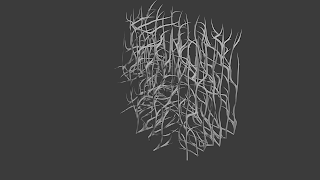"An 18th-century writer Johann Wolfgang von Goethe stated, “Music is liquid architecture and Architecture is frozen music”. Goethe's statement is probably in reflection with the Baroque architecture style of those times - The graceful contours, the twisting elements and the dramatic spatial sequences all mimicking the harmony, rhythm and texture in music."(Feby Susan Philip)
This is the journey of points. They create connections, spots or even time itself. We will discover how they can be our source to question architecture with its norms.
ACT 1
The first Act is all about locating the points randomly (as much as possible in manual) and start to connect them from the source to the ending points which are at the edge of the square. First the main lines are set and the other points are connected to either the closest points or the main line according to the distance.
(One source point connecting to 4 ending points)
(3 source points connecting to the 4 closest ending points using each others main lines if necessary)
(4 sourcee points connecting to the 4 ending points but this time ending points are not on the square's frame)
(Adding griddal component to add another showcase to the system)
(3 source points to 4 ending points with griddal application at one of them)
(2 source points to 2 ending points but there is an obsticle on the way)
(1 source point to 2 ending points but there are obsticles on the way)
The first act prompted some questions as well as linking some nerves. One of them is about "how articulating nature works". Is copying a components paradigm in an artificial manner actually help us articulate the environment? Or it is just a joke that only us humans can understand or believe. How can a steady object like a building can articulate nature when nature constantly in change, by only copying some rules? The change of the nature works with its own paradigms and rules.
When one of much parameter changes, the paradigm will change. Maybe the way to articulate it either obeying the parameters or be opossed to it. In fact every little parameter in itself is opposed to the nature. This is how they create the environment. Creating ones own paradigm can also be a way to articulate nature.
The other point to question is about whatness of intercommunication. Is it always good to acces somewhere easily, or accesing there in the hard way makes it more valuable. Maybe this can be one of the architectures paradigm to articulate.
ACT 2
The second Act is a set of digital experiments to understand the relationship of the points. They seem to be divided the points to be reached (ending point) and the points from which we start (source point). This set is mostly created with Blender's "Shortest Edge Paths Node"
The most basic of them all was just about connecting three source points to one ending point in two dimension, using noise texture the different ways was discovered.
The "greater than" and "less than" nodes makes it a bit more interesting, every point on the grid now are connected to the ending point (on the left hand side).
The other experiment was about decentralizing the points as much as possible
The other experiment was to be able to control where the connections are gonna be set in an exact manner by attributing certain points to the connections. Step by step more source points are added which makes the connections to gain length over time. But since they are connected to the closest ending point they will not be unified.
This time the nodes were gained the other dimenison with displacement nodes. Again since the ending points are at the edge of the grid every point goes to the closest point. With noise texture different connection types can be applied.


After Extruding the 2D objects into 3D this time it was turn to apply it to the 3rd dimension.
The second act tries to find ways to create its own paradigms, questioning architects role to create the paradigms themself by only defining the parameters and their values, This enables us to see what we cannot imagine by ourselves.
ACT 3
Act 3 will question interactions of points and the dimension we often lack to consider; time. This will be the last anchor point to defining Defrostation.
My initial thoughts of points was about their defining spots by themselves and the connections that surround them. While the experiment above I realized that it is much more than that. While the concept of spots mostly 2, sometimes 3 dimensional in architecture, the fourth dimesion is never entangled; time.
Architecture is now expert at 2 dimension. Most of our tools of representation and communication is at 2 dimensional, it appears that most of our building stock are extruded two dimensional objects. They are steady and sturdy. With the last century we can say that we also work with the third dimension, computer programs and new concepts help us construct our buildings in the third dimension. But it is hard to say that time is a thing that affects the architecture in normal manner.
"Defrosting Architecture" term comes from Goethes' words "Architecture is frozen music". The 18th century literator. The beauty of arhcitecture was in its frozen shape. But especially after 20th century this standarts are changed. The current building stock was absent and new movements were on the horizon.
The paradigms of architecture has already started to change. The new standarts are far from to be set. As it is indicated "Field Conditions" by Stan Allen. The paradigms of Le Corbusier's Venice Hospital is a lot different than St Petrus. The unity is not the main component of architecture anymore. Time
does not accept unities. With time new unities appear and disseppear.





















